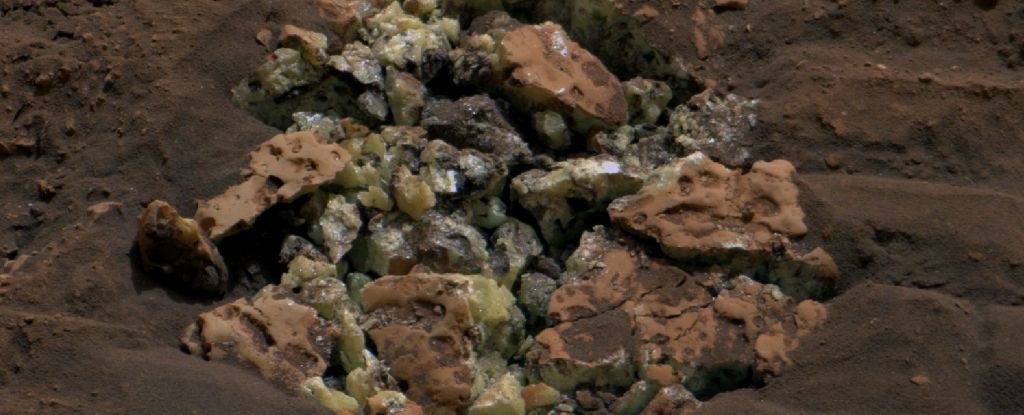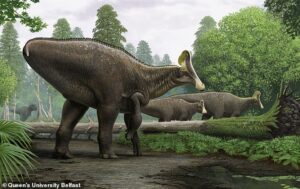A rock on Mars has just spewed out a surprising yellow treasure after Curiosity accidentally cracked through its unremarkable exterior.
As the rover rolled its 899-kilogram (1,982-pound) body over the rock, the rock split open, revealing yellow crystals of elemental sulfur: brimstone. Although sulfates are quite common on Mars, this is the first time sulfur has been found on the red planet in its pure elemental form.
Even more excitingly, the Gediz Vallis channel where Curiosity discovered the rock is littered with boulders that look suspiciously similar to the sulfur rock before it was accidentally crushed—suggesting that elemental sulfur may somehow be abundant there at some places.
“Finding a field of rocks made of pure sulfur is like finding an oasis in the desert,” said Curiosity project scientist Ashwin Vasavada of NASA’s Jet Propulsion Laboratory.
“It shouldn’t be there, so now we have to explain it. Discovering strange and unexpected things is what makes planetary exploration so exciting.”
Sulfates are salts that form when sulfur, usually in compound form, mixes with other minerals in water. As the water evaporates, the minerals mix and dry, leaving the sulfates behind.
These sulfate minerals can tell us a lot about Mars, such as its water history and how it has weathered over time.
Pure sulfur, on the other hand, forms only under a very narrow set of conditions that are not known to have occurred in the region of Mars where Curiosity made its discovery.
To be fair, there’s a lot we don’t know about the geological history of Mars, but the discovery of piles of pure sulfur just hanging on the Martian surface suggests there’s something pretty big we’re not aware of.

It is important to understand that sulfur is an essential element for all life. It is usually taken in the form of sulfates and is used to make two of the essential amino acids that living organisms need to make proteins.
Since we have known about sulfates on Mars for some time, the discovery does not tell us anything new in this area. In any case, we have yet to find any signs of life on Mars. But we keep coming across remnants of bits and pieces that living organisms would find useful, including chemistry, water, and past habitable conditions.
Stuck here on Earth, we’re pretty limited in how we can get to Mars. Curiosity’s instruments were able to analyze and identify the sulfur-bearing rocks in the Gediz Vallis channel, but if it hadn’t taken a route that overturned and opened one up, it could have been a while since we found it.
The next step will be to figure out exactly how, based on what we know about Mars, this sulfur might have gotten there. This will take a bit more work, possibly involving detailed modeling of the geological evolution of Mars.
frameborder=”0″ allow=”accelerometer; automatic execution; clipboard-recording; encrypted media; gyroscope; picture in picture; web sharing” referrerpolicy=”strict-origin-when-cross-origin” allowfullscreen>
Meanwhile, Curiosity will continue to collect data on the same. The Gediz Vallis Channel is an area rich in Martian history, an ancient waterway whose rocks now bear the imprint of the ancient river that once flowed over them billions of years ago.
Curiosity has drilled a hole in one of the rocks, taking a powdered sample of its interior for chemical analysis, and is now making its way deeper down the channel to see what other surprises might be waiting just around the next rock.



